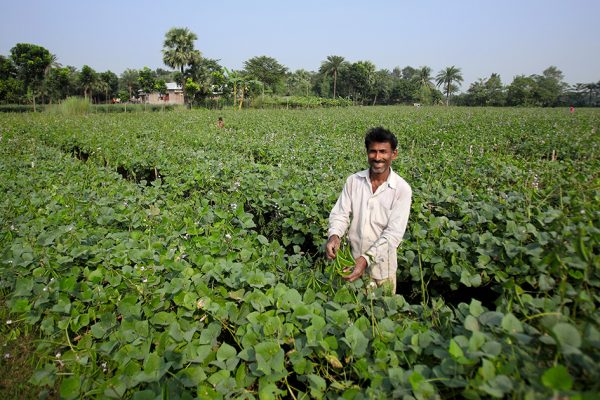The story of Shanta, neighbor and care provider: How BRAC is making tuberculosis history
Reading Time: 4 minutes
On the occasion of the launch of its book Making Tuberculosis History: Community-Based Solutions for Millions, Bangladesh-based BRAC is sharing stories about those taking part in its successful approach to combating TB. The following is the first in a series.By Maria A. May, BRAC Health Program
On the occasion of the launch of its book Making Tuberculosis History: Community-Based Solutions for Millions, Bangladesh-based BRAC is sharing stories about those taking part in its successful approach to combating TB. The following is the first in a series.By Maria A. May, BRAC Health Program
Shanta, a resident of Badda, a vibrant slum in northern Dhaka, is a face of the new Bangladesh. Every day she finishes her morning tasks at home and heads out into the bustle to begin her work. Around her, the streets pulse with energy: vendors offer freshly cut grapefruit and guava, stores and stalls spill over with cheap household items imported from China, cell phone ring tones sound endlessly. Once a country of villages, Bangladesh has been transformed as the promise of economic opportunity draws the rural poor to Dhaka, population 15 million and rising.
Rapid urban migration has squeezed the capital. Increasingly horrendous traffic chokes the roads, and power outages, a lack of basic sanitation and a dearth of public services are the norm here. Conditions are ripe for the spread of tuberculosis (TB), an airborne bacterial infection that kills about 5,000 people every day around the world. But there is also hope and opportunity: It is here in Bangladesh, that BRAC, the world’s largest anti-poverty organization, has developed a successful approach for confronting the threat of TB, described in its upcoming book, Making Tuberculosis History: Community-Based Solutions for Millions.
Shanta is a living embodiment of the organization’s success. She is part of BRAC’s all-female army of 88,000 “community health promoters” (shasthya shebika in Bangla) – lay practitioners who form the pillars of BRAC’s anti-TB strategy. Shanta and tens of thousands like her visit households in their communities every day, selling simple health products like vitamins and sanitary napkins, while inquiring about persistent coughs, fevers, and other symptoms of TB. These women identify individuals with symptoms, and with BRAC’s help, facilitate testing and diagnosis.
For those who test positive, a lengthy course of drug treatment begins. This is where Shanta’s work becomes crucial, for one of the most worrying aspects of TB treatment is the potential development of dangerous drug-resistant strains. In order to prevent that, patients must complete the full course of drug treatment. Though medication is provided for free by the government, BRAC requires new patients to hand over a small deposit, returned only after taking the medicine regularly for six months, ensuring the bacterial infection is eliminated completely. Shanta, like other community health promoters, makes sure the patients take their medication each day as prescribed.
“Patients usually want to stick to the treatment,” says Shanta. But unexpected disruptions, mobile lifestyles and stress often make it difficult. People need a support mechanism that’s nearby and flexible. Patients, too, admit that without her help, they’d likely forget to take the medication sometimes. If they need to travel outside the slum – back to their home villages for a few days, for instance – Shanta gets involved, helping them plan the trip, often identifying a temporary guardian to make sure they continue to take the required medication.
For those TB patients living in the surrounding streets of Badda, Shanta is both a friendly neighbor and care provider. Patients confide in her, often sharing personal matters during visits to her home, where they come for daily treatment. (Most live within a five to 10 minute walk and like to stop by on their way to work.) If unable to come, they call her mobile phone, and she usually responds with a personal visit. For every patient of hers that successfully completes treatment, Shanta receives 150 Bangladeshi takas (US$2) from BRAC, helping her support her own three children.
Building on its success in providing health care to rural communities, BRAC has trained an urban cadre of health promoters to reach slum dwellers as villagers increasingly pack up for the cities. The organization now accounts for about 66 percent of all TB cases treated in Bangladesh.
Emerging from its earliest experiments providing TB treatment to rural villages lacking access to government health care in the 1980s, BRAC’s method has brought it under fire. Numerous public health experts, government officials, donors and human rights activists pushed BRAC to change its delivery strategy, which usually involves a bond system whereby patients put down a small deposit prior to beginning treatment, returned only if they complete the full course. The organization refused, citing program data and research that supported its approach.
Simply put, BRAC’s model works. With adherence an Achilles’ heel for treating infectious diseases like TB, BRAC has found a way to engage patients and motivate them to continue the full course of treatment. It has tested the model in the field, defended it from critics, and scaled it up to become one of the largest such programs in the world – thanks, in large part, to women like Shanta. BRAC has brought similar methods to Afghanistan with great success, and has promising pilots underway in Uganda and Liberia.
Since 1994, Bangladesh’s National Tuberculosis Program has led a consortium of non-governmental organizations in creating systems that offer free treatment to all. This partnership has expanded since the arrival of resources from the Global Fund to Fight AIDS, Tuberculosis and Malaria in 2004, reaching deeper into communities across the country. In 2010, over 45 partners participated in national anti-TB efforts, treating 150,000 patients.
BRAC launches Making Tuberculosis History, on October 27 at the 42nd Union World Conference on Lung Health in Lille, France. For more information, write to makingtbhistory@bracusa.org.
Next in the series, we’ll feature the story of Shahida, one of Shanta’s patients.





